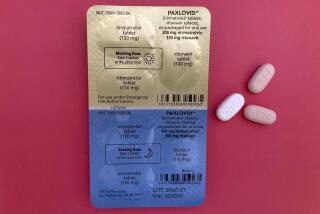GAO Reports Risks in Drugs FDA Approved
- Share via
WASHINGTON — More than half of all the drugs approved by the Food and Drug Administration between 1976 and 1985 were found to cause “serious” adverse reactions that in some instances led to hospitalization, disability and death, according to a General Accounting Office study released Sunday.
But the Department of Health and Human Services, responding to a draft of the report, criticized the methodology and added: “We are concerned that this report . . . will unnecessarily alarm consumers, causing some to reject the use of lifesaving drugs out of fear of adverse events that may occur only in extremely rare instances.”
“The GAO study is an important reminder that FDA approval does not guarantee that approved drugs are completely safe,” Rep. Ted Weiss (D-N.Y.) said in a statement.
The report said that of the 198 drugs approved by the FDA during the time studied, 51.5% had “serious post-approval risks” that required the addition of a warning to the label or, in rare cases, removal from the market. As of last September, all but six of these drugs were still being sold “and are deemed by the FDA to have benefits that outweigh their risks,” said the study conducted at the request of Weiss, chairman of the House Government Operations human resources and intergovernmental relations subcommittee.
Some of the unexpected reactions included heart failure, breathing difficulty, respiratory arrest, convulsions, seizures, kidney and liver failure, severe blood disorders, birth defects and blindness, the report said.
The report also determined that drugs reviewed for use in children were twice as likely to have serious post-approval risks.
HHS complained that the study failed to discuss the benefits of the drugs, including those with severe risks.
“Many drugs have saved lives and improved the quality of life for millions of people,” said a statement from HHS. “Some of the drugs that have had post-approval identification of risks are also the only available treatment, the best available treatment, or second-line treatment for use when other drugs have failed.”
Jeff Nesbit, a spokesman for the FDA, added: “Even the most extensive pre-market testing can never cover all possible circumstances. Testing perhaps 3,000 people over a period of months or years won’t always identify a rare reaction unfolding over a long time, or affecting perhaps just one person in 10,000.”
To reach their conclusions, the GAO investigators studied label changes in the drugs in the years following their approval to determine whether subsequent adverse reactions had occurred. The FDA, which monitors post-approval adverse reactions, typically adds a warning to the drug label if serious problems are reported. Occasionally, when the problems are severe and widespread enough, the agency will remove the drug from the market.
The GAO, however, did not compile information that indicated the number of serious reactions that were experienced, so it was unclear how many persons were actually affected by problems with the drugs. The FDA does not necessarily add a warning to the label based on the number of incidents, but rather on the severity of the reaction, even if it is a rare occurrence.
According to the GAO report released by Weiss, drugs with serious post-approval risks were often approved in a shorter time than drugs found to have no risks.
This finding may renew the debate over accelerating the drug approval process in order to speed new drugs to the public, as has begun to happen in recent years with experimental AIDS treatments and drugs for other life-threatening conditions.
As a result of the AIDS epidemic, federal health officials have expressed a new willingness to make experimental drugs more accessible to the public before they have been thoroughly studied. Although regulators have emphasized that this will apply only to drugs for typically fatal diseases where there are few or no therapeutic alternatives, some experts have expressed fears that unanticipated or unpredictable toxicities could occur as a result.
The report is also timely because Congress is debating legislation that would limit a drug manufacturer’s liability for damages solely on the grounds that the drug had FDA approval. The GAO noted that it did not attempt to determine whether the risks could have been discovered during pre-approval testing, the extent to which patients were exposed to the risks before they were identified or the number of patients affected.
“However, these findings make it clear that further understanding is needed of the characteristics associated with these additional risks and why they arose,” the report said.
The report also found that certain classes of drugs had more problems with serious post-approval risks. Among these categories were heart, anti-inflammatory, psychopharmacologic, dermatologic and antibiotic drugs.
The report further found that many of the serious risks were manifestations of less severe side effects known by the agency at the time it approved the drug.






